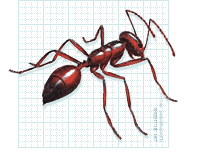 Known and feared for being aggressive when disturbed, fire ants pose a relatively recent threat in several Canadian provinces. The European fire ant is an introduced ant species; it began to appear more prevalently throughout Canada in the early 2000s. While many people assume fire ants bite when attacking, they actually use a combination of biting and stinging to inject venom and ward off intruders. To start the stinging process, fire ants bite the skin of the victim and pinch the tissue. The mandibles, or mouthparts, of the fire ant prick the skin and raise it enough to create a target for the stinger. Extending from the abdomen of the fire ant, the stinger is attached to an internal poison gland and resembles a hypodermic needle in structure. The fire ant thrusts the stinger into the raised skin held between the mandibles and injects the burning venom.
Known and feared for being aggressive when disturbed, fire ants pose a relatively recent threat in several Canadian provinces. The European fire ant is an introduced ant species; it began to appear more prevalently throughout Canada in the early 2000s. While many people assume fire ants bite when attacking, they actually use a combination of biting and stinging to inject venom and ward off intruders. To start the stinging process, fire ants bite the skin of the victim and pinch the tissue. The mandibles, or mouthparts, of the fire ant prick the skin and raise it enough to create a target for the stinger. Extending from the abdomen of the fire ant, the stinger is attached to an internal poison gland and resembles a hypodermic needle in structure. The fire ant thrusts the stinger into the raised skin held between the mandibles and injects the burning venom.
Fire ants are capable of stinging multiple times and often attack in swarms.
Why do they bite?
Like other stinging insects, fire ants bite and sting when disturbed or threatened. The dreaded ant species lives in underground nests, which the insects defend aggressively. Fire ant nests feature a distinctive mound that pushes upwards and causes the surface of the ground to bulge visibly. Humans and other animals that inadvertently step on the mound often fall victim to fire ant attacks. In addition to the noticeable mound, the nests of fire ants frequently include tunnels located just beneath the surface of the ground. The aggressive insects habitually exit the nest to attack passers-by walking on the ground directly above the tunnels, as well. Fire ants also bite and sting when encountered aboveground while foraging for food.
Symptoms
Though fatal to many small animals, fire ant bites usually only cause humans to have mild reactions of irritation. The venom of the sting initially produces the uncomfortable burning sensation for which the fire ant is named. Initial symptoms may also include itchiness, redness, and swelling at the site of the wound. The most distinctive symptom of a fire ant bite is the blister, called a pustule, that contains fluid and forms within six hours to a day after the sting occurs. The pustules typically diminish after a week or two and sometimes leave behind scabs or scarring lasting an additional three to ten days. While most humans endure mild and localized symptoms to fire ant bites, some people react more severely. People strongly allergic to the venom may experience difficulty breathing, an increased heart rate, swelling of the throat, nausea, vomiting, and shock. Symptoms indicative of a severe allergic reaction require immediate medical attention. Despite the potentially severe symptoms, less than 1% of fire ant bites result in anaphylaxis.
You may also like
Top Pests Expected To Trend In The Summer Of 2023
Warm weather is around the corner, which means pests that have been overwintering or hibernating will wake up as well as non-hibernating pests will start making an appearance outdoors. Being prepared for those spring and summer pests can have an impact on how enjoyable your time will be at home or at work. Using industry leading expertise, we have put together a comprehensive list on the top 8 pests expected to trend in the summer of 2023. This list will provide a deeper dive into the impact that pests can have on your property, along with prevention tips to keep your home or business pest-free.
Top 4 Tips For A Pest-Free Halloween
You may have been tricked by the plastic bats and fake spider webs in your neighbourhood, but the pests trying to make your house their home can be the scariest trick during Halloween. From rodents trying to trick or treat inside your home to flies trying to enjoy your jack-o’-lanterns, pests are always looking for ways to get into the Halloween spirit (and your home). Don’t worry, you’re not alone in trying to pest proof your home, as your Orkin Canada Pro has put together a list of 4 quick tips that will help you keep pests out this Halloween.
4 Easy Tips To Pest Proof Your Garden
Spring is the perfect time to get the garden tools out and start getting the garden box ready to grow some vegetables and your favourite flowers. You might do this every year, or this is your first attempt at gardening, regardless of your experience level, we're here to help you keep pests out. Our experienced Ph.d. entomologist Alice Sinia has put together a few easy and simple tips keep your garden pest free.
Practical Ways To Prevent Warm Weather Pests
Spring has arrived, and the pests are already starting to make their usual rounds. As they seek food, water and shelter, your home is like a bug and rodent oasis just waiting to be occupied. But nobody likes surprise invaders in their living space, which is why it’s crucial to recognize the most common threats and take action to prevent them.
Remove pests from your home, and stop them from coming back
We work hard to listen, understand and assess your unique situation. Request a free, no-obligation estimate today for a customized pest program that fits your needs.
Request a Free Home EstimateRequest a Free Business Consultation

